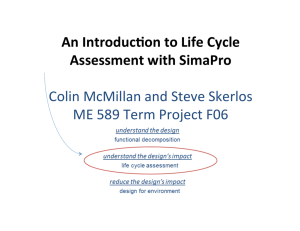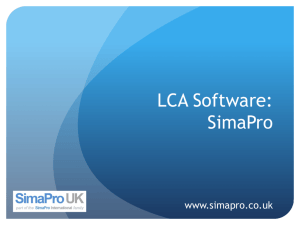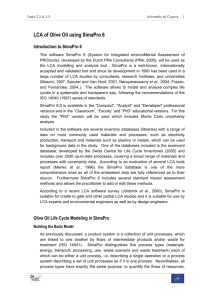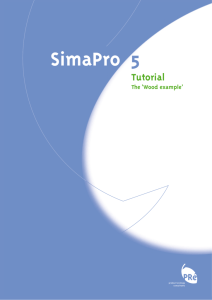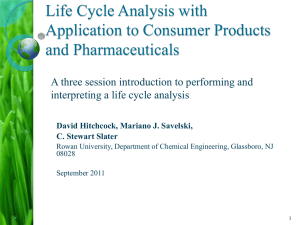SimaPro 8 Training Slides Jan 2014
advertisement
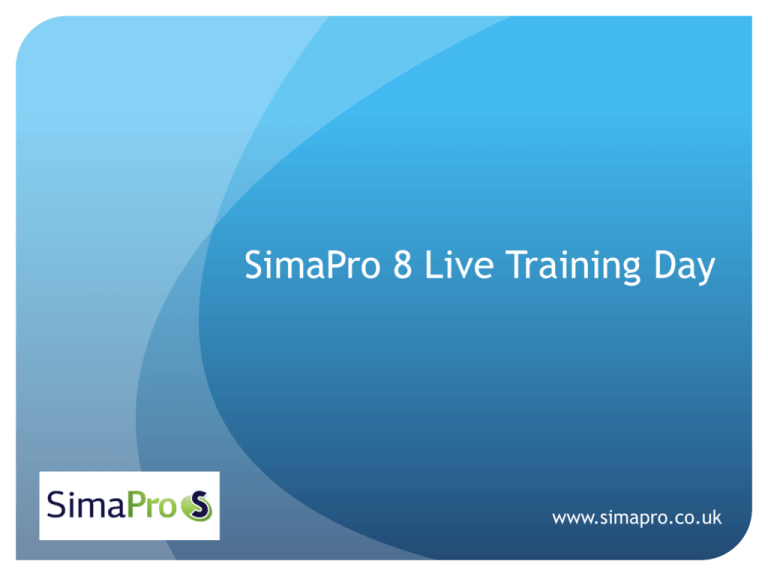
SimaPro 8 Live Training Day
www.simapro.co.uk
What is LCA?
The product life cycle
Material extraction
Emissions
Component manufacture
Waste
Product manufacture
Energy
Product sale
Water
Product use
Product disposal
2
Resource
use
www.simapro.co.uk
SimaPro 8 and Ecoinvent 3
• SimaPro 8 incorporating Ecoinvent 3 has recently been released
• SimaPro 8 comes with Ecoinvent 3 included in the price (SimaPro 7
users with current service contracts can upgrade at no extra cost)
• Ecoinvent 3 contains over 10,000 processes (compared to 4000 in
Ecoinvent 2)
• Processes are more up-to-date and more global
• There are new waste scenarios for EU countries
• Water footprinting is now implemented
• There are new allocation methods such as for recycling
• There are now Transformation processes and Market processes
• A consequential LCA database has been added
• Method updates include CML, ReCiPe, BEES
• New support documents have been produced
(Introduction to LCA, SimaPro Tutorial etc)
3
www.simapro.co.uk
LCA in SimaPro
The basic structure in SimaPro
Life Cycle
Assembly
Waste Scenario
Processes
4
www.simapro.co.uk
LCA in SimaPro
Of course it can be much more complex…
Life Cycle
Assembly
Waste Scenario
Re-use
Process
Process
Process
5
Process
Process
Process
Process
Process
Process
Waste
Process
Waste
Process
Disassembly
Recycling
Waste
Process
www.simapro.co.uk
LCA in SimaPro
SimaPro does not look like a flow diagram at first
SimaPro process for the production of 1 kilogram of dolomite:
Product produced
Dolomite
Amount
Inputs from the technosphere
Blasting
Electricity, medium voltage
Diesel, burned in building machine
Light fuel oil, burned in boiler 100kW
Heat, light fuel oil, at industrial furnace 1MW
Industrial machine, heavy, unspecified, at plant
Conveyor belt, at plant
Recultivation, limestone mine
Mine, limestone
Amount
7.73E-05
0.0325
0.018
0.00359
0.0898
0.000231
2.78E-08
6.52E-06
5.25E-11
Unit
kg
kWh
MJ
MJ
MJ
kg
m
m2
p
Resource use
Water, well, in ground
Occupation, mineral extraction site
Transformation, to mineral extraction site
Transformation, from forest
Dolomite, in ground
Amount
2.93E-05
8.48E-05
6.52E-06
6.52E-06
1
Unit
m3
m2a
m2
m2
kg
6
Unit
1 kg
Emissions to air
Heat, waste
Particulates, < 2.5 um
Particulates, > 10 um
Particulates, > 2.5 um, and < 10um
Amount
Emissions to soil
X
Amount
X
Unit
X
Emissions to water
X
Amount
X
Unit
X
0.117
0.00000887
0.000121
0.0000478
Unit
MJ
kg
kg
kg
www.simapro.co.uk
LCA in SimaPro
The flow diagram is an output at the end
This figure shows a network tree for
the production of 1kg of chipboard.
Identifies large impacts that can be targeted for
improved measurement or reduction.
Where do the impacts come from?
Is this an important factor and should we spend
more time measuring it?
7
www.simapro.co.uk
The functional unit
What is the functional unit?
“A measure of the function of the
products or services being studied”
Therefore the functional unit of a
construction I-beam might not be
“The production of one I-beam” as
this probably wouldn’t measure its
true comparative function.
The Functional Unit could be “the support of 5 tonnes of ceiling for 30 years”.
The Reference Flow is the amount of a product required to achieve that
functional unit.
Usually an Assembly is one item (one product), and the Reference Flow
(defined in the Life Cycle stage) is the number of items required to achieve
the Functional Unit.
8
www.simapro.co.uk
Installing SimaPro
• The latest version can be downloaded from www.simapro.co.uk
(today we have it on a USB key)
• During installation add in the name exactly as written and cut/paste in the
registration code
• The full version can also be downloaded by anyone, but is only fully
functional when the registration code is added
• The computer specs are not too challenging but to work with complex LCA
models a reasonably powerful computer is best:
• Any modern processor
• 4Gb RAM or more (2Gb will work but will be slower)
• 8GB hard disk space (1 GB for program plus 7GB for database
and temporary calculation files)
• Monitor resolution of 1280 x 1024 or more
• Windows XP or later (Windows 7 or 8 recommended)
9
www.simapro.co.uk
Installing SimaPro
Registration name:
Training SP UK
Registration code:
UAAAAAIASSxaiAAIAAAA#
hJinZXzAHFX7N8opymCUU3fWvqFafs1eGIjcJkl1xMYGwm
akZU2ZO2e0RYeVKD4o+JP6KtdBlhnQfpRxQhkkbdj+JwxX
+31jaCr7wGgVoc0v1hywBCETkT2rxidG0KDDhP6Sdkb9Bn
1TNsxDwLkkSLZ5kx9vRpM1N4laYL2nN2M=
10
www.simapro.co.uk
Opening SimaPro
The opening screen provides information on
the version use and service contract expiry.
Click on ‘OK’ to continue.
Select the database you
wish to open – often there
is only one database
named Professional –
choose that.
Open an existing project or create a
new project – in this case create a
new project called Training.
11
www.simapro.co.uk
Opening SimaPro
Click on “Libraries” on the left and untick them all
except these two:
Ecoinvent 3 – allocation, default – system
Methods
12
www.simapro.co.uk
SimaPro Structure
SimaPro is based on the use of windows:
13
www.simapro.co.uk
The key area of the screen
14
www.simapro.co.uk
The LCA Explorer
Category selection is normally shown as a tree menu, with a plus and
minus option button. When a category is selected it populates the other
sections of the LCA explorer.
15
www.simapro.co.uk
Product stages
There are 5 different categories available
in the Product Stages section:
• Assembly
è
• Life cycle
• Disposal Scenarios
• Disassembly
• Reuse
First we are going to focus on the
product stage called Assembly
Product stages
16
www.simapro.co.uk
An Assembly is a Product
Think of an Assembly as an
Assemblage
è
or
Item
or
Product stages
17
Product
www.simapro.co.uk
Creating an Assembly
So how do you create an Assembly?
To create an
Assembly, select
‘Product stages’ on
the LCA Explorer
menu.
Then select
‘Assembly’ and
‘Others’ in the
category section.
The ‘New’ category/data option button on the right will then become
available. Selecting ‘New’ will open the ‘New assembly’ window.
18
www.simapro.co.uk
Creating an Assembly
You will notice “(Insert line here)”.
This is a common feature to all SimaPro processes.
Double clicking on this allows you to add a link to another
process or assembly.
You can then specify how much of that process/assembly you
require.
19
www.simapro.co.uk
Creating an Assembly
Double clicking ‘(Insert line here)’ under ‘materials/assemblies’ will
automatically open another window called ‘Select a material process or
an assembly’
This window allows you
to select from any of the
materials available in
the database (or any
existing assemblies you
may have already
created).
Category
/data
options
It is split into the same
sections as the LCA
explorer
Category section
20
Data filter
Data section
Data background section
www.simapro.co.uk
Creating an Assembly
The ‘New assembly” window is used to create an assembly.
The three key inputs in this window are:
Name – The name you
want to give to your
Assembly.
Materials/Assemblies
– The physical
“bits and pieces” that make
up your product: materials
(and perhaps other
assemblies) that are linked
to this Assembly.
Processes
– The “non-material stuff” that goes into making your
product: energy and transportation processes that are
linked to this Assembly.
21
www.simapro.co.uk
Creating an Assembly
In the category section you
have an Assembly and
materials option. The
Assembly section contains
all of the Assemblies that
you may have already
created in your project.
The materials section
contains all of the material
processes in the SimaPro
database and contains a
number of sub-categories.
22
www.simapro.co.uk
Creating an Assembly
To the right of the window you have the data/category options buttons.
The most essential of these buttons are Select and Find.
‘Select’ allows you to link
your Assembly to the process
you’ve selected in the data
section.
‘Find’ allows you to search
for a specific process within
the database.
Once you’ve hit select or double clicked on the process you want to select,
the window will close and the name of the process will appear in your new
Assembly window.
23
www.simapro.co.uk
Creating an Assembly
Double clicking ‘(insert line here)’ under ‘Processes’ automatically opens
a similar window called ‘Select a process’.
In the categories section
you have “Process” and
sub-categories called
Energy, Transport
Processing and Use.
These are processes
within the database that
cannot be described as
materials.
However, the same method is applicable for selecting the process you want
to link to your assembly.
24
www.simapro.co.uk
Creating an Assembly
Now we’ve created a link to another process you need to specify how much of
the material or process you require for your assembly.
This can be done in
the ‘amount’ and
‘unit’ cells next to
the name of the
process you’ve
selected.
The unit option relates directly to the process you’ve selected so if it represents
a material you'll be allowed to select from a range of physical units relating to
its mass or volume. To change the unit simply double click on the cell.
25
www.simapro.co.uk
Creating an Assembly
Once you’ve finished creating your Assembly, click on the disk icon at the top
of the page and the Assembly will appear in data section of the LCA Explorer
window. You can then shut the New assembly window.
26
www.simapro.co.uk
Creating a Life Cycle
Life cycles are created in a very similar way to assemblies.
To create a
life cycle, select
‘Product stages’ on
the LCA Explorer
menu.
Then select
‘Life cycle’ and
‘Other’ in the
category section.
The ‘New’ category/data option button on the right will then become
available. Selecting ‘New’ will open the ‘New life cycle’ window.
27
www.simapro.co.uk
Creating a Life Cycle
The ‘New life cycle” window used to create the Life Cycle of the
Assembly. The three key inputs in this window are:
Name – The name you
want to give to your
Life Cycle.
Assembly – The
Assembly that you want to
feed into the Life Cycle.
Waste/Disposal
scenario – The Waste
Scenario you want the
Life Cycle to feed into.
28
www.simapro.co.uk
Creating a Life Cycle
Double click on the empty cells to link the Life Cycle to the Assembly and
Waste Scenario of your product.
If you double click under
Assembly you’ll find that the
‘Select an assembly’ window
that appears only allows you
to select from the Assembly
category in the category
section.
29
www.simapro.co.uk
Parts of an Assembly
Once you’ve selected an Assembly you can only quantify it in the unit
‘P’ (you cannot specify a unit).
The ‘P’ stands for ‘Parts’ and
represents the number of
Assemblies you require to
achieve the reference flow of
the Life Cycle.
(You don’t specify an amount
because the number of
‘Parts’ will automatically
decide how much of your
Assembly flows into the Life
Cycle.)
30
www.simapro.co.uk
Waste scenarios
A Waste scenario is what it says: a scenario.
Dictionary definition of scenario:
“a postulated set of options or events”
“a plot of a story”
“a situation involving various aspects”
So a waste scenario involves
various materials going through
various routes to various treatments.
A Waste treatment is one of those
specific routes/treatments. Think of
a waste treatment plant.
31
www.simapro.co.uk
Waste scenarios
If you double click under Waste/disposal scenario the “Select a disposal
scenario or a waste scenario process” window will appear.
In this window, options in the
category section are limited to
disposal scenarios or waste
scenarios.
Waste scenarios are processes
within the existing database which
automatically split the physical
materials in your assembly to specific
waste treatment processes.
Often you will want to choose a
Waste England scenario.
32
(Disposal scenarios are specialised
user-built models of disassembly and reuse.)
www.simapro.co.uk
Remember … PAWS
PAWS:
Processes > Assembly > Waste Scenario
33
www.simapro.co.uk
Remember … PAWS
PAWS:
Processes > Assembly > (via Life Cycle to) > Waste Scenario
34
www.simapro.co.uk
Impact assessment
Impact assessment
turns a
Life Cycle Inventory
into a
Life Cycle Assessment
35
www.simapro.co.uk
Impact assessment
An impact assessment is conducted by using the ‘Calculation setups’ on the
LCA Explorer menu.
If you select calculation
setups you are again
presented with a screen
that is split into sections.
Category
/data
options
The data section shows
the names of any saved
impact assessments
within that category.
To create a new setup
click on the “New” button
in the category/data
options.
Category section Data section
36
Data background section
www.simapro.co.uk
Impact assessment
A new window will then appear entitled “New calculation setup”. This is where
the impact assessment is created. It allows you to specify which Life Cycle you
want to assess and how you want to assess it. The key inputs are:
Name – The name you
want to give to the
calculation setup.
Calculation function –
Allows you to specify the
outputs of the assessment
(this time leave as is).
Method – The impact
assessment method you
wish to use.
Product – The material,
assembly or life cycle you
wish to assess or compare.
37
www.simapro.co.uk
Impact assessment
You can select which impact
assessment method you wish
to use by double clicking on the
cell under ‘methods’.
This will open the “select a
method and a normalisation/
weighting set” window.
38
www.simapro.co.uk
Impact assessment
The calculation function has a number of options available:
Analyse – Allows you to analyse a single process/assembly/life cycle
Compare – Allows you to compare a number of processes/assemblies/
life cycles
Tree – Shows the analysis of a single process/assembly/life cycle in the
form of a tree diagram
Network – Shows the analysis of a single process/assembly/life cycle in
the form of an amalgamated tree diagram
Uncertainty analysis – Allows you to conduct an uncertainty analysis on
a process/assembly/life cycle or a comparison.
39
www.simapro.co.uk
Impact assessment methods
Which method?
The short answer:
ReCiPe Endpoint (H)
Europe ReCiPe (H/A)
The long answer is very long …
40
www.simapro.co.uk
Impact assessment methods
The categories section splits the methods into European (CML, ReCiPe), North
American, Other single issue (IPCC GWP, LIC results) and superseded.
In the data
section you
can see the
name of the
impact
assessment
method.
To select a method
click on it and then
click on select.
In the data information section you can see details of the impact assessment
including any normalisation and weighting selection options associated with it.
41
www.simapro.co.uk
Impact assessment
You can select the material/
assembly/life cycle you want to
assess by double clicking on
the cell under ‘Products’.
This will open the “Select a
product/process or product
stage” window.
42
www.simapro.co.uk
Impact assessment
In the category section two main categories are available: processes and
product stages.
Within Processes you can
select any of the existing
database processes on the
production of materials, use
of energy, transportation etc.
Within Product stages you
can select any of the
assemblies or life cycles you
have created.
(Often you will be assessing
a life cycle under Product
stages.)
43
www.simapro.co.uk
Impact assessment
Once we’ve finished creating the calculation setup, click on the disk icon at the
top of the page and the setup will appear in data section of the LCA Explorer
window.
Then click on Calculate and your impact assessment will be conducted.
44
www.simapro.co.uk
Impact assessment
The impact assessment window will then open with the following tabs.
Impact assessment results
Inventory of the materials and substances used
Which materials and substance have impacted on each category
Flow diagrams
Result
type
Which substances have not been included
Table
form
Graphical
form
45
www.simapro.co.uk
Impact assessment
Results!
46
www.simapro.co.uk
Discussion and Data Investigation
Transport
Electricity
47
www.simapro.co.uk
Open another Library Project
Click on “Libraries” on the left and tick a third library project:
Ecoinvent 3 – allocation, default – unit
(Why are we not opening more libraries? – a discussion about old
databases, the new consequential database etc)
48
www.simapro.co.uk
Unit Processes versus System Processes
What are Unit Processes and System processes?
The short answer:
Unit processes show everything, System processes are summaries
The long answer …
49
www.simapro.co.uk
Processes
Practical
Find a thermoplastic, open the unit process (U) and see what is in there:
(Select “Processes”, find thermoplastics in
Plastics/Thermoplastics/Transformation,
open a plastic, look under the Input/Output tab):
What inputs?
What outputs?
ç
What materials and energy are used?
What wastes occur?
What waste type is it defined as?
(We will discuss “Polypropylene, granulate {RER} / production / Alloc Def, U”)
50
www.simapro.co.uk
Processes
It is often easiest to model your own material by making a copy of an
existing one and modifying it.
Find a unit process in Ecoinvent that is
the closest to what you want, select
Copy, give it a new name, and adjust
as required.
(If you start creating a new process
from scratch, make sure you define
what the waste type is. This controls
how the material is disposed of.
For instance, if you accidentally define
cardboard as a mixed plastic waste
type, the impacts at end of life might
be higher than they really should be.)
51
www.simapro.co.uk
The Philosophy of LCA: Elegant Modelling
“The only 100% accurate
model of the universe
is the universe itself”
Albert Einstein
No LCA model is 100% accurate. The aim
is to create a model that simplifies reality
into a useful form.
The best LCA practitioners can see how to
simplify a system into an elegant model.
This takes practice and experience.
Novice LCA practitioners often get lost in
unnecessary complexity. Complexity should
only be added where it adds value.
One way to avoid getting bogged down in
non-useful complexity is to make a quick,
simple model first. This will help to reveal
which aspects are worth modelling in more
detail.
“You have to simplify in a clever way”
Mark Goedkoop
52
www.simapro.co.uk
Example
Drink in glass bottles or bulk
plastic bottle:
• Glass bottle holds 700ml of
drink and weighs 427 grams
empty
• PET bottle holds 5 litres of drink
and weighs 97 grams empty
53
www.simapro.co.uk
Example
Functional unit is 1 PET bottle
equivalent (5 litres of drink):
• 7.143 glass bottles are equal to 1
PET bottle
(because 700ml x 7.143 = 5000ml)
So the fair comparison is:
7.143 glass bottles to 1 PET bottle
• Another way of looking at this:
3050 grams of glass is equal to 97
grams of PET
(because 7.143 x 427g = 3050g)
So another way to achieve a fair
comparison is:
3050g of glass to 97g of PET
54
www.simapro.co.uk
Let’s get working!
We are going to model it this way:
1. A standard PET production
process (1kg) going into
1 PET bottle Assembly,
of which 1 bottle (plus 600km
of transport) go via a Life Cycle
into a standard England waste
disposal scenario.
2. A standard glass production
process (1kg) going into
1 glass bottle Assembly,
of which 7.143 bottles (plus
600km of transport) go via a
Life Cycle into a standard
England waste disposal
scenario.
55
www.simapro.co.uk
Disposal scenarios and Reuse
The Product stages section also includes a number of other
product stages in addition to Assembly, Life cycle and Waste
scenario. These are:
• Disposal scenario
• Disassembly
• Reuse
These are more specialised product stages that you will only
have to use if you need create your own specialised disposal,
disassembly and reuse models. If your product uses a
standard municipal waste route (or any other waste scenario
already in Ecoinvent) you will not need these three product
stages.
56
www.simapro.co.uk
Disposal scenarios and Reuse
A Disposal scenario is a more complex version of a Waste scenario.
A Disposal scenario allows you model re-use (and, if needed, disassembly).
Disposal
scenario
Life cycle
Assembly
Processes
Materials/Energy
Disassembly
Reuse
Waste scenario
Waste treatments
Elementary flows
57
www.simapro.co.uk
Disposal scenarios and Reuse
The creation of a ‘Disposal scenario’ is very similar to the creation of a Life cycle.
Go to ‘Disposal scenarios’ and ‘Other’ in the category section and then select ‘new’.
The ‘New disposal scenario’ window will appear.
A reference Assembly
has to define the
reuse product stage it
can be linked to.
Processes can also
be added that occur
at this stage.
You link the disposal scenario to a waste scenario and a reuse product stage and
specify the percentage going to each.
58
www.simapro.co.uk
Disposal scenarios and Reuse
The modelling of Reuse is similar.
The reference
Assembly acts as an
avoided product and
must be the same as
the reference
Assembly in the
Disposal scenario
You can then define any processes that occurs prior or during the reuse of the
Assembly.
59
www.simapro.co.uk
Disposal scenarios and Reuse
In both cases the amount of disassembly or reuse must match the amount in the
Assembly.
Usually an Assembly would be 1 item (such as 1 PET bottle or 1 glass bottle), so the
amount of disassembly or reuse must also be for 1 item (1 PET bottle or 1 glass
bottle).
In other words, the amount of disassembly or reuse should not necessarily match the
amount in the Life Cycle (the reference flow) but should always match the amount in
the Assembly.
Disposal
scenario
Life cycle
Assembly
Disassembly
Reuse
The amount here should match the amount here
60
www.simapro.co.uk
Formulae and Parameters
If you are familiar with using formulae and parameters in Excel or
computer programming languages, you will find it easy in SimaPro.
If you are not comfortable using these aspects in Excel you might find it
not worth the trouble in SimaPro!
In SimaPro a formula can be added more or less anywhere a number is
required. The only difference from Excel is that it should not start with an
equals symbol.
Example:
Excel:
=(5*2)/(100*10)
SimaPro:
(5*2)/(100*10)
61
www.simapro.co.uk
Formulae and Parameters
Parameters are the same as variables in computer programming.
You can define a name as a certain number or formula, and then
refer to that name in other places. Parameters are highly recommended
if you are comfortable with the concept.
Exercise:
In Parameters:
Define a parameter called petweight = 97
Define a parameter called glassweight = 427
Then in your Assemblies enter the names petweight and glassweight
rather than the numbers
The advantage is that you can change the weight once in the
Parameters section, and the weight will be updated wherever
the names are used.
62
www.simapro.co.uk
It’s a wrap
63
www.simapro.co.uk
Summary
We have covered six key aspects of creating LCAs in SimaPro 8:
1. DATA AND PROCESSES: The use, adaptation and creation
of processes.
2. ASSEMBLIES: The creation of Assemblies to bring processes
together into products – the “cradle to gate” element.
3. LIFE CYCLES: The creation of Life Cycles to turn Assemblies
into complete “cradle to grave” life cycles.
4. END OF LIFE: The development of Waste Scenarios and
Disposal Scenarios to model end of life activities and Reuse.
5. IMPACT ASSESSMENT: The use of impact assessment
methods to analyse the environmental impact of a life cycle inventory.
6. NEW FEATURES: The main developments in the new versions
of SimaPro and Ecoinvent.
64
www.simapro.co.uk
End of Day
Two websites:
www.simapro.co.uk
www.pre-sustainability.com
Two contact options:
UK email: support@simapro.co.uk
NL support line: +31 33 450 4010
